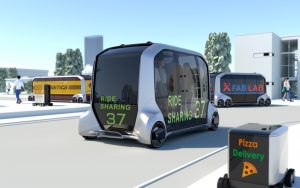Perhaps nothing made me smile more at this year’s Consumer Electronics Show (CES) in Las Vegas than “self-driving stores on wheels.” And that’s high praise for a show that features aisle-to-aisle eye candy.
As a fan of pop-ups and discovering creative ways to deal with retail’s “empty space” issue, I have to say that Toyota’s 23-foot-long e-Palette Alliance (shown), a fully autonomous, battery-electric concept vehicle, is a sophisticated addition to the potential opportunities coming to our industry. Launch partners include Amazon.com Inc., DiDi, Mazda, Pizza Hut and Uber, all of which will collaborate on vehicle planning, application concepts and vehicle verification activities.
One of the retail-specific scenarios shown was a mobile store that arrives at a customer’s door with various footwear options. He tries on what he likes and makes his purchase, and the shop zips away. This information is huge for the design industry – from environmental graphic design to brand strategy – we’ll have a new way to extend our talents. How cool will it be to see your design work in an inline space and flying down the highway?
In the short-term, this group of companies will focus on the development of the new e-Palette concept, which reflects one of Toyota’s visions for automated-mobility-as-a-service (Autono-MaaS) applications. (MaaS is another term to add to our design lexicon.)
With its open interior design, the vehicle can be outfitted with purpose-built interiors (designed by us) in accordance with the user’s needs, whether it be parcel delivery or on-the-road e-commerce. Its flexible framework is also designed for usage optimization, allowing the open-source concept to be shared to support various business needs and transition seamlessly from one application to another. Other examples included a drone platform that could be launched from the vehicle to deliver products to customers’ front doors.
Toyota plans to conduct feasibility testing of the concept in various global regions, including the U.S., in the early 2020s, as the driverless standard becomes more factored into cityscapes. Beyond the Toyota concept, there was much to see at CES that may directly impact the retail community. For one, shape-shifting mannequins aren’t so futuristic after all.
A French company was at CES to demonstrate its unique mannequin designs; the company characterizes itself as a specialist in robotic technology, focusing on morphology and bio-mimicry. While we’ve seen adaptable mannequins before, none have incorporated mechanisms that morph to all shapes and sizes in a rapid manner, but their application for retail is clear.
Advertisement
Smart mirrors and sensors have invaded the changing room, offering us even more on-the-fly customizations. So why not showcase mannequins that take your exact shape and allow you to see the outfit, on what’s essentially “your” body (but without the hassle of undressing and dressing time after time). Imagine, one minute it’s a size 16 and the next a size four, then back to a size eight, all supported by digital imagery showcasing the beauty of all body types.
Also top of mind at the show, the visual magic of augmented reality (AR) should bring about new opportunities this year. How will designers utilize AR tools to view new fixture or decor items in the actual store environment in advance of purchase orders? Or to simply determine what lighting changes may be required in advance of an installation?
Creative teams might catalogue props at a lab and create a “visual standards manual” template to be utilized by others in the field. Imagine a heads-up display that explains step-by-step window installation directions to teams around the world, ensuring compliance and design intent is met. The next-gen is 3-D hand-tracking that will allow us to interact with and move objects just as we would in real life (think: “Minority Report”). Just as touchscreens have become a standard part of our lives, so too will gesture-based AR.
AR will become a key filter through which we will see the world of design options. It allows you to view your real surroundings and augmented elements as one, which can have a powerful effect on the way we use our smartphones in an environment to make decisions. AR allows your device to use information about what’s surrounding you in real time without goggles, and that potential will make store site inspections and reviews take on a new dimension.
The retail world will continue to be influenced by technology, and the design of experiences heavily influenced by our ability to tap resources and execute them well.
Advertisement


 Photo Gallery3 days ago
Photo Gallery3 days ago
 Headlines1 week ago
Headlines1 week ago
 Sector Spotlight2 weeks ago
Sector Spotlight2 weeks ago
 Headlines1 week ago
Headlines1 week ago
 Headlines4 days ago
Headlines4 days ago
 Headlines2 weeks ago
Headlines2 weeks ago
 Designer Dozen1 week ago
Designer Dozen1 week ago
 Headlines2 days ago
Headlines2 days ago
















